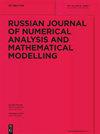北冰洋热含量变率低频模态的可预测性:一种完美的模式方法
IF 0.6
4区 数学
Q4 MATHEMATICS, APPLIED
Russian Journal of Numerical Analysis and Mathematical Modelling
Pub Date : 2022-04-01
DOI:10.1515/rnam-2022-0008
引用次数: 0
摘要
摘要:本文考虑了由INM RAS开发的INM- cm5地球系统模式运行的工业化前气候模拟数据对北冰洋上层温度的潜在可预测性问题。重点分析了北冰洋环流低频变率主要模态相位的可预测性。对其可预测性的初步估计是通过使用类似物的方法和计算不变测度的共振来实现的。然后用该模型的直接集合计算验证了这一估计。结果表明,15年平均热含量的最大可预报时间间隔可达10年,对应于沿主要低频变率模态的最大正异常状态。本文章由计算机程序翻译,如有差异,请以英文原文为准。
Predictability of the low-frequency modes of the Arctic Ocean heat content variability: a perfect model approach
Abstract The problem of potential predictability of the temperature of the upper layer of the Arctic Ocean for the data of pre-industrial climate modelling run by the INM-CM5 Earth system model developed at the INM RAS is considered. The main attention is paid to the analysis of predictability of the phases of the dominant modes of low-frequency variability of the Arctic Ocean circulation. The initial estimate of its predictability is made by using the method of analogues and calculating the resonances of the invariant measure. Then this estimate is verified by direct ensemble calculations with the model. The results obtained indicate that the maximum predictability time interval reaches ten years for 15-year average values of heat content and corresponds to the states with maximum positive anomalies along the leading low-frequency variability modes.
求助全文
通过发布文献求助,成功后即可免费获取论文全文。
去求助
来源期刊
CiteScore
1.40
自引率
16.70%
发文量
31
审稿时长
>12 weeks
期刊介绍:
The Russian Journal of Numerical Analysis and Mathematical Modelling, published bimonthly, provides English translations of selected new original Russian papers on the theoretical aspects of numerical analysis and the application of mathematical methods to simulation and modelling. The editorial board, consisting of the most prominent Russian scientists in numerical analysis and mathematical modelling, selects papers on the basis of their high scientific standard, innovative approach and topical interest.
Topics:
-numerical analysis-
numerical linear algebra-
finite element methods for PDEs-
iterative methods-
Monte-Carlo methods-
mathematical modelling and numerical simulation in geophysical hydrodynamics, immunology and medicine, fluid mechanics and electrodynamics, geosciences.

 求助内容:
求助内容: 应助结果提醒方式:
应助结果提醒方式:


